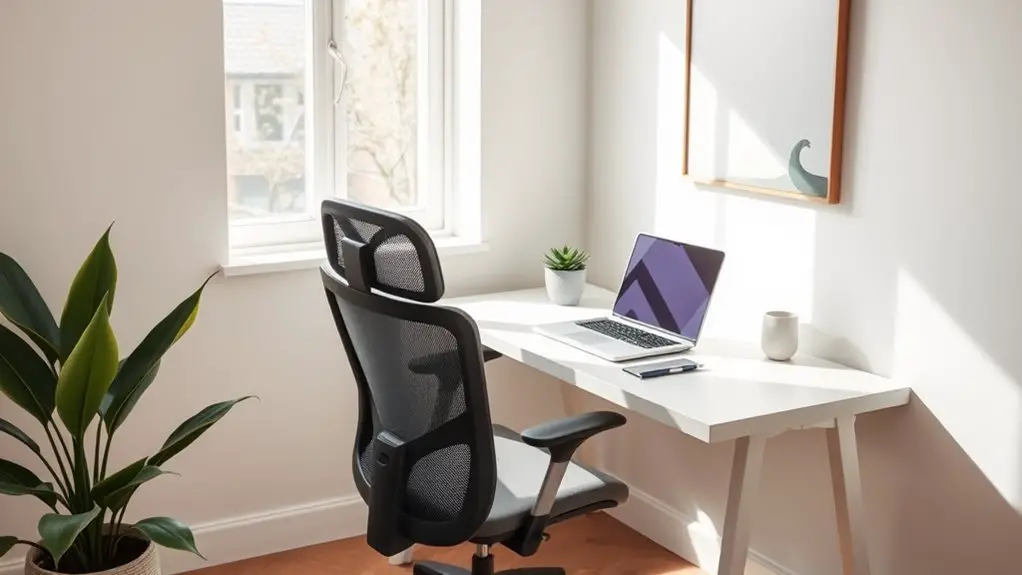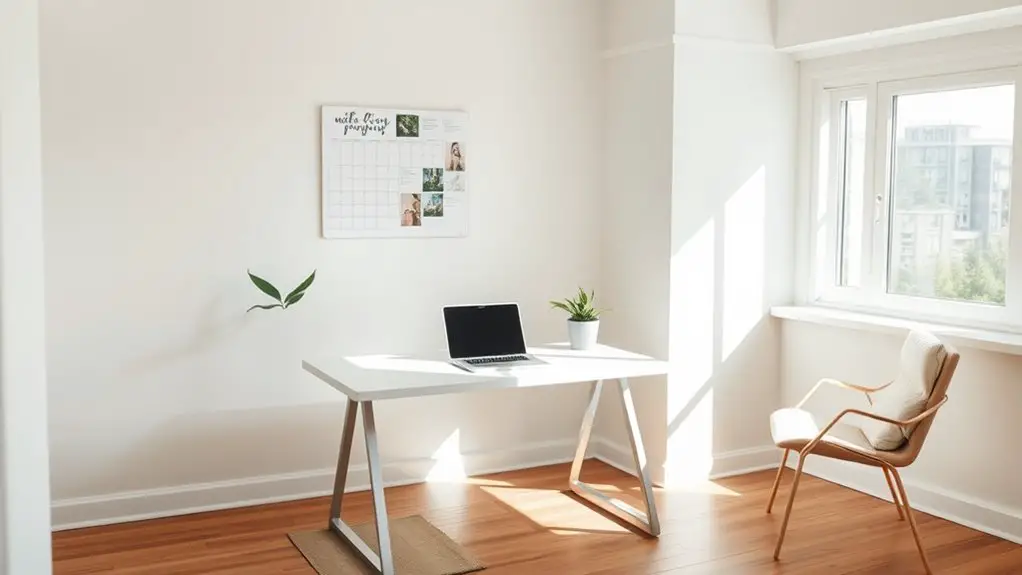To create a distraction-free workspace in seven days, start by designating a dedicated area that's clutter-free and energizing. Set clear work boundaries and routines to minimize interruptions. Manage digital distractions by turning off non-essential notifications and using apps to block distractions. Incorporate noise reduction strategies, like noise-cancelling headphones and acoustic panels. Finally, cultivate mental focus through mindfulness practices. Stick with it, and find out how to keep your productivity high and motivation strong.
Key Takeaways
- Designate a dedicated workspace with ergonomic furniture and natural elements to enhance comfort and productivity.
- Establish clear work hours and routines to set boundaries and minimize interruptions from family or housemates.
- Manage digital distractions by turning off non-essential notifications and using productivity apps to block distracting websites.
- Create a noise-reduction strategy, such as using noise-cancelling headphones or acoustic treatments, to minimize surrounding distractions.
- Incorporate mindfulness practices, like short meditation sessions or mindful breathing, to cultivate focus and reduce stress throughout the day.
Designate Your Dedicated Workspace

Creating a dedicated workspace is essential for maximizing your productivity and maintaining a healthy work-life balance. By separating work from home life, you'll create an environment that boosts focus and job satisfaction.
Invest in ergonomic furniture to enhance comfort and minimize distractions. A clutter-free space helps maintain mental clarity, while personalizing your workspace with meaningful décor can elevate your motivation.
Invest in ergonomic furniture and personalize your space to boost comfort, clarity, and motivation.
Incorporating natural elements like plants or ample light can uplift your mood, making you more productive. Noise-cancelling headphones can also help manage sound distractions. Moreover, the average age of coworking space members worldwide is 36 years, indicating that a well-designed workspace appeals to professionals across various age groups.
While leasing a dedicated space may seem costly, the productivity gains and improved work environment often outweigh the expenses.
Ultimately, a well-designed workspace fosters better focus and efficiency, setting you up for success.
Establish Clear Boundaries and Routines
To create a distraction-free workspace, you need to establish clear work hours and communicate them effectively to others. This not only sets expectations for your availability but also helps maintain your focus and productivity. Additionally, setting boundaries with family members or housemates can further reinforce your commitment to uninterrupted work time.
Set Work Hours
While you might feel tempted to work around the clock, setting clear work hours is essential for maintaining productivity and mental well-being. Research indicates that your productivity dips after 50 hours of work per week. Instead, aim for a balanced 38-hour week to thrive. Furthermore, longer hours do not guarantee higher productivity and may lead to burnout.
Here are some tips to help you establish effective work hours:
- Create a Schedule: Map out your ideal work hours and stick to them.
- Designate Break Times: Incorporate breaks to recharge and maintain focus.
- Set Boundaries: Communicate your work hours to minimize interruptions.
- Prioritize Tasks: Focus on high-priority tasks during your peak productivity hours.
Communicate With Others
Establishing clear boundaries and routines is essential for effective communication in the workplace. Clearly communicate your work limits to colleagues using direct language, so everyone knows what's acceptable.
Define what constitutes an emergency to eliminate confusion, and be sure to outline consequences for boundary violations, like reduced availability. Document any incidents of disrespect for future reference.
Create a morning routine that boosts your productivity, incorporating exercise or meditation to get your mind ready. Setting these boundaries helps promote mental health benefits like reduced burnout and increased job satisfaction. Set up your workspace to minimize distractions and implement time management techniques, like the Pomodoro Technique.
Turn off non-essential notifications and use "Do Not Disturb" mode during focused work. This way, you foster a respectful environment where everyone can thrive.
Manage Digital Distractions Effectively

As digital distractions become increasingly prevalent in the workplace, effectively managing them is essential for maintaining productivity and focus.
Start by implementing these strategies:
Start by adopting effective strategies to manage digital distractions and boost your workplace productivity.
- Manage Notifications: Turn off non-essential alerts and use "Do Not Disturb" mode during work hours to minimize interruptions.
- Implement Digital Distraction Policies: Advocate for company policies that restrict non-work content and support apps that help you stay focused.
- Utilize Productivity Tools: Leverage apps that block distracting websites, and consider techniques like the Pomodoro Technique to enhance your time management. A clutter-free desk layout minimizes distractions and promotes concentration, making it easier to focus on your tasks.
- Educate Yourself and Others: Discuss the impact of digital distractions and track your time to better understand your habits.
Create a Noise-Reduction Strategy
To create a truly distraction-free workspace, you'll want to focus on noise reduction strategies that work for you. Noise-cancelling headphones can be a game-changer, providing personal sound control in any environment. Additionally, implementing soundproofing techniques can greatly enhance your overall focus and productivity. Incorporating acoustic treatments such as wall panels and sound-proof insulation can further minimize distractions and improve your workspace's overall acoustic quality.
Noise-Cancelling Headphones Benefits
Noise-cancelling headphones can transform your workspace into a sanctuary of focus and productivity.
By reducing ambient noise, they create an environment where you can truly concentrate. Active noise cancelling (ANC) technology uses built-in microphones to detect and neutralize surrounding noise, enhancing your listening experience.
Here are four key benefits:
- Enhanced Focus: Block out distractions and immerse yourself in your tasks.
- Improved Audio Clarity: Enjoy crystal-clear sound for music and calls, eliminating background chatter.
- Increased Work Efficiency: Minimize interruptions, leading to higher quality work in less time.
- Stress Relief: Reduce mental fatigue and stress from constant noise exposure, allowing for a calmer mind.
With these headphones, you can elevate your remote work experience or study sessions, making your workspace a more enjoyable and productive place.
Soundproofing Techniques Overview
Creating a distraction-free workspace requires a thoughtful approach to soundproofing, especially if you want to enhance focus and productivity. Start by identifying noise sources in your environment.
Use acoustic panels and foam to absorb sound and minimize reverberation. Consider high-density vinyl or mineral wool for effective sound blocking. Implement decoupling techniques to reduce vibrations and damping methods to convert sound waves into heat. Damping reduces resonance and can be particularly beneficial in controlling unwanted noise.
Mass addition can further decrease sound transmission. Designate quiet areas for focused work, and optimize your workspace location away from high-traffic zones.
Cultivate Mental Focus and Mindfulness

While distractions can easily derail your focus, cultivating mental clarity through mindfulness can substantially enhance your productivity.
By incorporating mindfulness techniques into your daily routine, you can sharpen your attention and reduce stress.
Here are four effective strategies to help you cultivate mental focus:
- Mindful Breathing: Practice focused breathing exercises to activate your brain's attention networks.
- Daily Meditation: Set aside time for meditation, enhancing clarity and reducing stress levels. Research indicates that regular mindfulness practices improve attentional control and cognitive performance, making this an essential component of your routine.
- Mindful Moments: Take short breaks throughout the day to reconnect with your breath and clear your mind.
- Awareness of Distractions: Recognize when your focus drifts and gently guide your attention back to the task at hand.
These practices can lead to improved cognitive performance and sustained attention in your workspace.
Maintain Productivity and Motivation
Mindfulness techniques can considerably enhance your mental focus, but to truly maintain productivity and motivation, you need to establish a conducive workspace. Start by designating a specific area free from household distractions, and invest in ergonomic furniture to boost comfort and reduce fatigue. Incorporate elements of nature, like plants or natural light, to elevate your mood, as incorporating plants and greenery can also improve air quality. Keep your workspace organized; a tidy environment fosters mental clarity. Set clear work boundaries and create a routine to define your work hours. Prioritize tasks and use techniques like the Pomodoro Technique to stay on track. Don't forget to take regular breaks to refresh your mind, and utilize productivity apps to minimize digital distractions. This structured approach will keep you engaged and motivated.
Evaluate and Adjust Your Workspace Regularly
Regularly evaluating and adjusting your workspace is essential for maintaining a productive environment.
Regularly reassessing your workspace is crucial for fostering a productive atmosphere.
You'll find that small tweaks can lead to significant improvements in focus and comfort.
Consider these four key areas for a workspace overhaul:
- Declutter: Keep surfaces clear to enhance focus and creativity.
- Ergonomics: Invest in ergonomic furniture to reduce discomfort and support productivity. Psychological appraisal can help identify your specific ergonomic needs.
- Natural Light: Incorporate natural light to elevate your mood and energy levels.
- Personalization: Add personal touches that inspire and motivate you.
Frequently Asked Questions
What Should I Do if I Can't Find a Quiet Workspace?
If you can't find a quiet workspace, consider using noise-cancelling headphones, creating a dedicated space at home, or utilizing local libraries. You can also schedule focused work during quieter hours to minimize distractions effectively.
How Can I Involve Family Members in My Workspace Boundaries?
Involve your family by openly discussing your workspace boundaries. Explain why they matter, set clear expectations, and encourage their input on household responsibilities. This collaborative approach fosters respect for your work time and strengthens family communication.
What Are Effective Ways to Declutter My Digital Files?
To declutter your digital files, start by organizing folders with clear names, regularly deleting unnecessary files, and backing up important data to the cloud. Schedule routine audits to maintain your streamlined digital workspace.
How Can I Stay Motivated During Long Work Hours?
To stay motivated during long work hours, set clear goals, take regular breaks, and celebrate small wins. Create a positive environment, involve yourself in your tasks, and keep your workspace organized for maximum focus.
What Signs Indicate I Need to Adjust My Workspace Setup?
If you're experiencing frequent discomfort, distractions, or poor lighting, it's time to adjust your workspace setup. Clutter, interruptions, or inadequate ergonomic furniture also signal a need for improvement to enhance your productivity and well-being.
